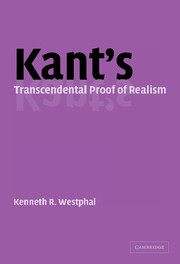Book contents
- Frontmatter
- Contents
- Acknowledgments
- List of abbreviations
- Introduction
- 1 Kant's methods: transcendental and epistemic reflection
- 2 The metaphysics of Kant's transcendental idealism
- 3 Transcendental affinity
- 4 The gap in Kant's Critique of Pure Reason
- 5 Kant's dynamic misconstructions
- 6 Kant's metaphysical proof of the Law of Inertia
- 7 Three Kantian insights
- Appendix
- Bibliography
- Index of names
- Index of subjects
5 - Kant's dynamic misconstructions
Published online by Cambridge University Press: 06 November 2009
- Frontmatter
- Contents
- Acknowledgments
- List of abbreviations
- Introduction
- 1 Kant's methods: transcendental and epistemic reflection
- 2 The metaphysics of Kant's transcendental idealism
- 3 Transcendental affinity
- 4 The gap in Kant's Critique of Pure Reason
- 5 Kant's dynamic misconstructions
- 6 Kant's metaphysical proof of the Law of Inertia
- 7 Three Kantian insights
- Appendix
- Bibliography
- Index of names
- Index of subjects
Summary
INTRODUCTION
Above (§30) I indicated three steps required to show that Kant's transcendental idealism fails in its own terms to justify causal judgments. In chapter 4 I argued that Kant's justification of causal judgments in the first Critique fails because it needs but does not justify the much more specific metaphysical principle, that every physical event has an external physical cause. Kant takes two main steps in the Foundations (MAdN) to fill this gap. First, he argues that matter can only be understood in terms of its two original constitutive forces. This requires justifying the ascription to matter of dynamic causal powers (chapter 5). Second, he argues on metaphysical grounds for the law of inertia. This law requires that causes of physical change must be external (chapter 6). Kant's metaphysical method in the Foundations is based squarely on his transcendental idealism. Consequently, the failures of his analyses of these two key points in the Foundations serve directly to undermine Kant's idealism because his idealism ultimately cannot provide the complete analysis and justification of causal judgments Kant claims it alone can provide.
Filling the gap in Kant's justification of causal judgments arising from the distinction between the transcendental and the metaphysical causal principles is an unofficial aim of Kant's Foundations. To understand how the Foundations is to fulfill this unofficial aim, as well as the implications of my criticisms of Kant's metaphysical analyses, requires considering Kant's official aims and methods in the Foundations. These are highly original, and not pellucid. The points of immediate concern are these.
- Type
- Chapter
- Information
- Kant's Transcendental Proof of Realism , pp. 173 - 204Publisher: Cambridge University PressPrint publication year: 2004

